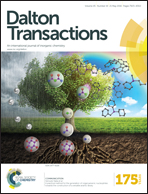New insights into the selectivity of four 1,10-phenanthroline-derived ligands toward the separation of trivalent actinides and lanthanides: a DFT based comparison study†
Abstract
Although many heterocyclic N-donor ligands have shown excellent competence for separating actinides from lanthanides, an explanation for why some ligands work whereas others fail is very fundamental but greatly needs to be addressed for designing novel and efficient extractants. In this work, we systematically investigated four phenanthroline-derived ligands, DHDIPhen, BQPhen, Ph2-BTPhen and CyMe4-BTPhen, and their coordination geometrical properties and formation reactions with Am(III) and Eu(III) ions by quasi-relativistic density functional theory. The calculated hardness of ligands, which may help to determine their selectivity toward actinides and lanthanides, yielded an order, from the softest to the hardest, as follows: Ph2-BTPhen < CyMe4-BTPhen < BQPhen < DHDIPhen. It shows that the intramolecular hydrogen bonds and size of a ligand cavity are two dominant factors for metal-ion complexation. Natural population analysis (NPA) reveals that the 5d/6d orbitals of Eu/Am accept significantly more electrons than other orbitals, but partial density of states and molecular orbital analysis prove that the d orbitals with more accepted electrons have little contribution to the metal–ligand bonds. The thermodynamic results suggest that ligand protonation does have a great influence on the complexation of ligands with metal ions but does not change the selectivity of ligands toward metal ions. This work can help in-depth understanding the differences of selectivity of various structurally similar ligands and provide more theoretical insights for designing more innovative ligands for Ln/An separation.


 Please wait while we load your content...
Please wait while we load your content...